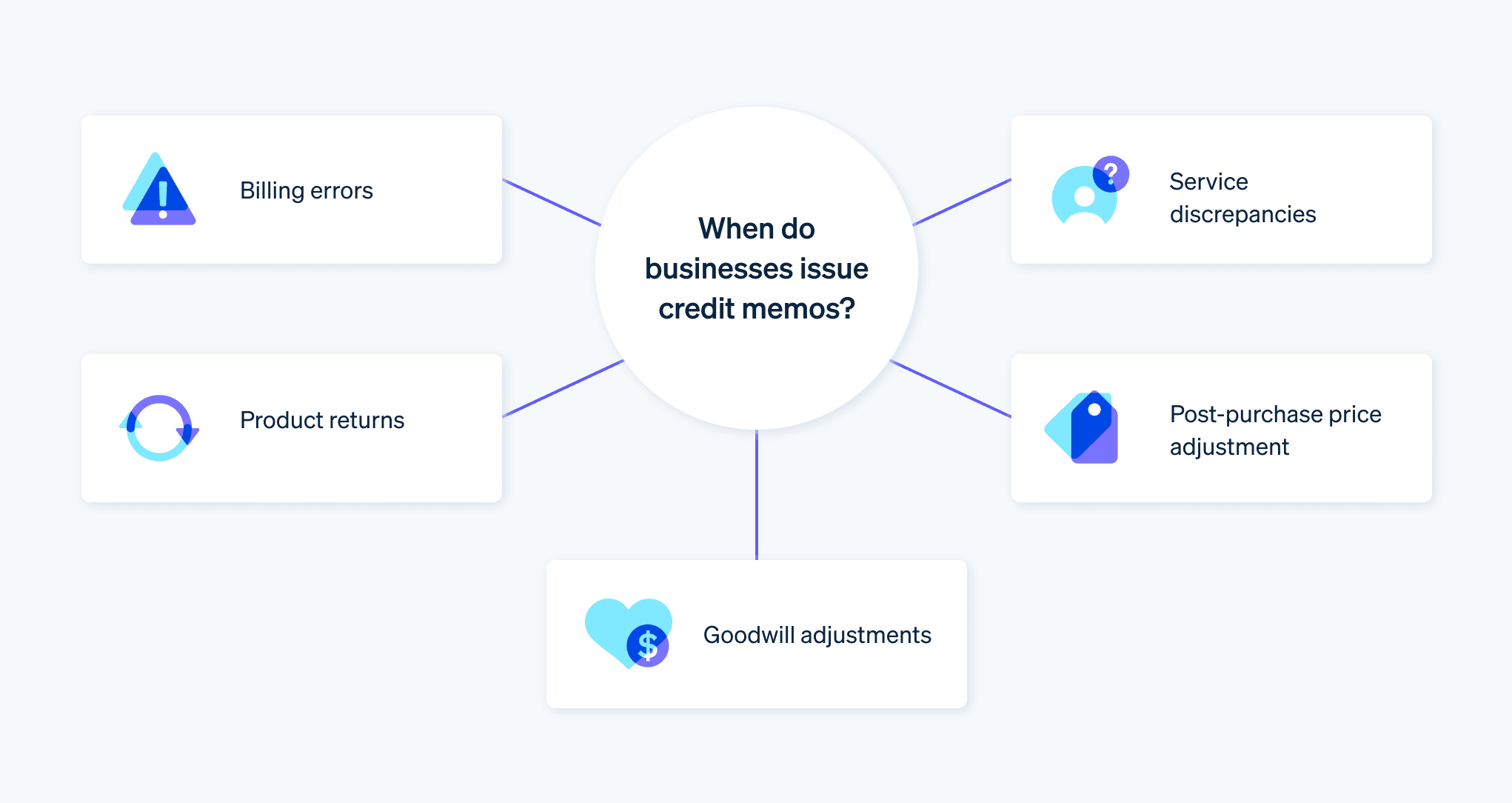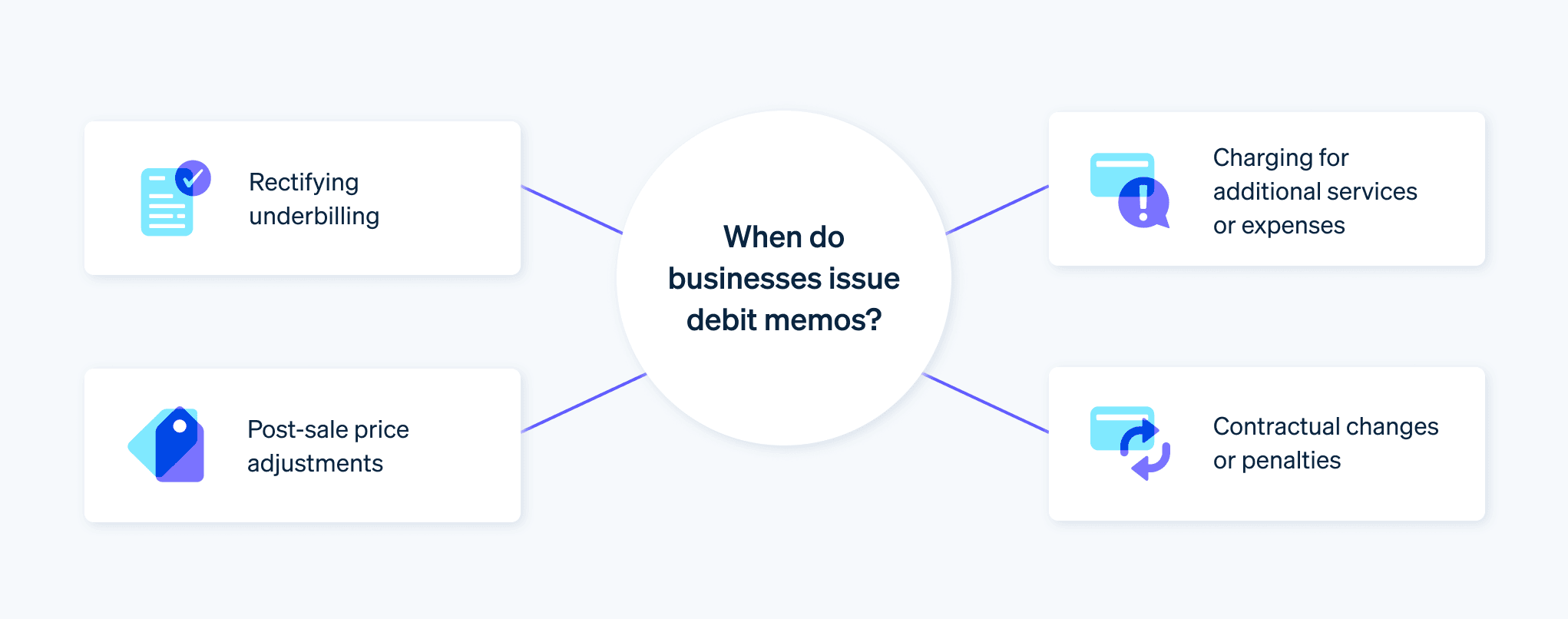企业明白,客户交易不会在销售后结束。经常会出现一些问题,例如多收费用或退货,需要进行财务调整。贷方和借方通知单是企业用来确保客户支付正确金额的简单工具。
贷方通知的作用类似于凭证,当企业欠客户钱时 — 例如,当客户被多收了钱或决定退货时 — 就会发出通知。企业使用借方通知单来表示客户欠他们更多的钱,通常是因为企业少收费或提供额外服务。
本文将解释贷方和借方通知单的细节,以及它们如何帮助企业保持财务完整性。我们还将提供模板供企业使用。无论您需要发出贷记还是借方通知单,您都将知道如何专业高效地处理。
目录
- 什么是贷方通知单?
- 什么是借方通知单?
- 为什么贷方和借方通知单对企业很重要?
- 企业何时发出贷方通知单?
- 企业何时发出借方通知单?
- 贷方通知单与借方通知单:主要区别
- 管理贷方和借方通知单的最佳实践
- 企业贷方通知单模板
- 企业借方通知单模板
什么是贷方通知单?
贷方通知单是卖方向买方发出的文件。它们更正或调整先前开具的发票,以纠正错误或提供贷记。
贷方通知单在企业对企业 (B2B)交易中很常见。它们具有多种功能,在会计和客户服务流程中发挥着作用。了解这些功能对于任何从事企业运营、财务或会计工作的人来说都非常重要。以下是贷方通知单的主要特点和目的:
更正计费错误
贷方通知单主要纠正计费中的错误,如多收费或为未交付的产品或服务计费。当企业发现错误时,就会发出贷方通知单来调整原始发票金额。这保证了财务记录反映实际交易价值,保持了会计记录的完整性。处理退货和退款
当客户因商品缺陷、不满意或装运错误而退货时,企业会发出贷方通知单。该文件调整应收账款,反映企业欠客户一定金额。企业可以将这笔付款作为代金券发放,用于今后的购物。记录折扣和津贴
贷方通知单还可用于记录卖方在原始交易后给予买方的任何后续折扣或补贴。这种调整可能是由于批量购买折扣、促销优惠或对不需要退货的小问题的补偿。维护客户关系
针对问题发出贷方通知单是一种善意的表示。这向客户表明,卖家承认错误并承诺纠正错误。这种做法可以维护和加强客户关系,因为它体现了卖方对客户满意度和公平性的承诺。库存调整
贷方通知单有助于产品退货期间的库存管理。它们可追踪退回的物品,以便企业相应调整库存水平,防止库存水平和财务报告出现差异。合规和记录保存
贷方通知单是监管合规和财务审计的一部分。它们为审计师和税务机关提供了书面线索,以核实财务报表的准确性。保留详细的贷方通知单的记录有助于企业展示透明度并遵守财务报告标准。财务调整的灵活性
如果客户对服务稍有不满,企业可以发放部分信贷,而不是全额信贷。
什么是借方通知单?
借方通知单与贷方通知单的作用相反:借方通知单显示和处理必须支付的金额的增加。以下是借方通知单的特点和功能概述:
少收费用的调整
如果卖方因定价、数量或计算错误而少收了买方的货物或服务费,可以开具借方通知单,而不是新发票。借方通知单增加了卖方账户的应付金额,纠正了账单差异。罚款或额外费用
有时,企业会使用借方通知单来收取费用或罚款。例如,在企业对企业交易中,如果卖方因延迟交货或不符合规格要求而未能履行合同条款,买方可能会开具罚款金额的借方通知单。有时,借方通知单用于收取额外费用或罚款,以便在财务上履行任何合同义务或商定条款 — 例如,逾期付款或未付款。记录保存和合规
借方通知单对于维护准确的财务记录非常重要。它们为财务审计提供书面线索,并确保符合会计准则。妥善管理借方通知单对于准确记账和财务报告非常重要。促进清晰的沟通
借方通知单可帮助买卖双方就财务调整进行清晰沟通。它们提供了申请和处理这些调整的正式方式。这种清晰度有助于防止误解。
借方通知单可帮助企业准确管理应付账款、保持合规性并维护健康的客户关系。它们使企业能够系统和专业地处理货币调整。
为什么贷方和借方通知单对企业很重要?
贷方和借方通知单是企业用来管理金融交易和客户关系的关键工具。这两种类型的通知单都会显著影响内部财务准确性、法规遵从性以及与客户的有效沟通。它们为财务审计提供清晰、有据可查的线索,帮助企业精确管理账目。
企业何时发布贷方通知单?
贷方通知单有助于企业保持准确的财务记录,并促进牢固的客户关系。以下是企业可能发出贷方通知单的典型情况:
计费错误
当您的企业开具发票错误,例如,由于定价错误或数量上的笔误而多收了客户的费用,则应发出贷方通知单。它承认错误,并开始纠正应付余额的过程。这样既能保证您的账目准确无误,又能向您的客户表明您对公平计费做法的承诺。例如,一家企业以每件 10 美元的价格销售 100 件商品,但由于错误,该企业向买家开具了 110 件商品的发票。意识到错误后,企业会为多收取的 10 个单位开具贷方通知单,减少了买方的账单或将其记入了买方的账户。产品退货
如果客户因产品瑕疵、不满意或与订单不符而退货,贷方通知单会调整发票金额,减少客户的应付余额。在这种情况下,贷方通知单可以使您的销售和库存记录保持一致,从而准确跟踪退货与销售之间的关系。例如,客户退回了价值 200 美元的有缺陷产品。企业为退回的产品开具贷方通知单,可以抵消未来的购买。服务差异
有时,提供的服务可能不符合客户的期望或合同协议。在这种情况下,贷方通知单可以调整服务的计费金额。这样既纠正了账单,又有助于与客户保持积极的关系,表明您对他们的关切有求必应。例如,向客户收取了 1,000 美元的服务费,但所提供的服务没有达到约定的标准。企业承认了这一点,并发出了 200 美元的贷方通知单作为部分贷项,以弥补差额。购买后价格调整
销售结束后,可能会出现需要调整价格的情况,例如,由于后续的折扣优惠或对忠实客户的特殊照顾。发出贷方通知单可追溯这些调整,以便根据最新的定价决定公平地向客户收费。例如,客户在购物后表示,他们有资格享受促销折扣,但却没有享受。企业发出贷方通知单以追溯应用折扣,调整客户的帐户余额。商誉调整
有时,您的企业可能会决定做出让步或调整,以示友好。在这种情况下,开具贷方通知单就是对这一调整的正式确认。例如,一位长期客户对最近的一次购物表示了轻微的不满。为了保持良好的关系,企业会发出一份小额信用凭证以示友好,鼓励今后的业务往来。
上述每一种情况都说明了贷方通知单在企业运营的多个方面(从会计准确性到客户关系管理)的重要性。贷方通知单在展示企业对道德实践和客户满意度的承诺方面也发挥着重要作用。

企业何时发出借方通知单?
企业使用借方备忘录来调整财务账目。以下是可能发出借方通知单的具体情况列表:
纠正欠款
如果您的企业意识到您向客户收取的费用太少,借方通知单有助于纠正错误。如果您定价错误、计算错误或忘记为部分服务计费,则可能发生这种情况。通知单委婉地告诉客户,他们还欠一点钱。例如,企业意识到由于计算错误,少向客户收取了服务费。如果原始发票金额为 1,000 美元,而实际金额应为 1,200 美元,企业就会开具一张 200 美元的借方通知单来更正账单。收取额外服务或费用
有时,在首次计费后会发生意想不到的费用。可能是客户要求额外的工作,也可能是您这边有不可预见的费用。通过借方通知单,您可以将这些费用添加到客户的账户中,使财务状况保持整洁和最新。例如,在完成一项服务后,客户要求完成最初协议中未包括的额外工作。如果额外服务的费用为 300 美元,则企业会发出 300 美元的借方通知单,并将其添加到客户的现有账单中。售后价格调整
达成交易后,价格可能会发生变化。如果您需要收取的费用高于最初商定的费用,则借方通知单会将这一变更告知客户。例如,合同可能允许根据市场情况调整价格。当这些条件导致价格上涨时,企业会向客户发出借方通知单,以支付新定价下的额外欠款。合同变更或处罚
合同中有时会有要求日后调整账单的条款,如每年提价。当需要应用这些更改时,您可以使用借方通知单让客户了解合同规定的新费用。例如,客户未能在约定期限内付款。根据合同条款,企业收取 50 美元的滞纳金。企业开具 50 美元滞纳金的借记单,将其计入客户的未清余额。
借方通知单可确保您的财务记录准确无误,并确保客户收到的服务或货物账单正确无误。

贷方通知单与借方通知单:主要区别
贷方和借方通知单在企业会计中有着不同的用途。让我们仔细看看它们之间的主要区别:
调整方向
当企业需要减少客户的欠款时,会开具贷方通知单。这通常发生在多收费用、产品退货或出现服务问题时。当企业需要增加客户的欠款时,它将使用借方通知单。这可能是由于计费不足、额外费用或售后价格调整。发出原因
企业发送贷方通知单主要是为了纠正多收的费用、处理退货或调整不满意的服务。这是一种“我们欠您的”的方式,其形式是为今后的购物提供信用额度。企业发出借方通知单来纠正少收的费用、增加交易后的费用,或因合同条款或价格变动而上调发票。对财务报表的影响
有了贷方通知单,企业的应收账款就会减少,因为企业要么欠客户钱,要么减少了客户的未清余额。它从您期望获得的报酬中减去这些钱。但是,借方通知单会增加应收账款。它表明客户欠的更多,增加了您期望收到的金额。客户关系动态
开具贷方通知单通常反映了企业对客户服务和公平性的承诺,尤其是当通知单涉及多收费用或不满时。虽然开具借方通知单是一种标准的商业惯例,但它需要清晰的沟通,以确保客户理解他们被要求支付更多费用的原因。内部业务流程
签发贷方通知单的过程通常涉及客户服务和质量控制部门,特别是在出现退货或服务问题的情况下。借方通知单可能需要与销售或合同管理团队进行更多的互动,特别是在处理账单不足或与合同相关的价格调整时。
贷方和借方通知单都会调整计费金额,但方向相反,原因也不同。了解这些细微差别有助于企业准确管理财务并维持健康的客户关系。
管理贷方和借方通知单的最佳实践
有效管理贷方和借方通知单对于维护准确的财务记录和健康的客户关系非常重要。以下是一些可供企业考虑的最佳实践:
清晰的文档和理由
每个贷方或借方通知单都应有文件支持。这意味着要详细记录原始交易、调整原因以及与客户就调整进行的任何沟通。说明通知单的理由可提高透明度,并在发生争议或审计时更容易参考。及时开具和处理
及时开具和处理这些通知单。延迟开具可能会造成混淆,并可能影响财务报告。及时处理贷方通知单,尤其是与退货相关的贷方通知单,是保持良好客户关系的关键。对于借方通知单,及时开具有助于确保企业及时收取额外费用。准确的会计分录
贷方通知单反映了收入和应收账款的减少,而借方通知单则反映了收入和应收账款的增加。准确的会计分录意味着您的财务报表反映了您企业财务的真实情况。与客户进行有效沟通
解释通知单的原因、对客户账户的影响以及客户需要采取的任何行动。良好的沟通可以避免误解,维护信任。与会计系统集成
在会计系统中处理贷方和借方通知单有助于您有效地管理它们。自动化系统可以标记差异,发送发出或处理提醒,并在您的财务报表中反映这些调整。定期审计和审查
定期审查和审计贷方和借方通知单交易。这将帮助您识别错误、了解客户关注的问题并遵守会计准则和政策。为工作人员提供培训和指导
员工应在处理贷方和借方通知单方面应训练有素。关于何时以及如何开具这些通知单的明确指南,再加上客户沟通和记录保存方面的培训,可以减少错误并提高效率。保密
在处理敏感的客户信息时,保密性很重要。安全地处理贷方和借方通知单及其包含的数据,保护您的企业和客户。
企业贷方通知单模板
下面是贷方通知单的模板。它的组织格式清晰而专业,能有效地向客户传达所有必要信息。您可以自定义此模板,以适合您公司的具体详细信息和各种情况的具体情况。
[您的公司名称]
[您的公司地址]
[城市、州、邮政编码]
[电话号码] | [电子邮件地址]
贷方通知单
日期:[开具日期]
贷方通知单编号:[唯一贷方通知单 ID]
收件人:
[客户名称]
[客户地址]
[城市、州、邮政编码]
参考:
原始发票编号:[原始发票 ID]
原始发票日期:[原始发票日期]
信贷详情:
|
项目描述
|
数量
|
单价
|
总额
|
|---|---|---|---|
| [项目或服务] | [数量] | [单价]美元 | [总额]美元 |
| [额外项目] | [数量] | [单价]美元 | [总额]美元 |
| 总贷记金额: | [合计]美元 |
信贷原因:
[提供贷方通知单的详细说明,例如多收费用、产品退货、服务差异等]
补充说明:
[包括任何其他相关信息或说明,如如何使用信用额度(如未来的购买信用额度)、任何后续操作等]。
授权人:[授权人的姓名和职务]
查询联系信息:
[提供联系信息,以便客户在对贷方通知单有疑问时取得联系。]
[您的公司名称]
企业借记通知单模板
下面是借方通知单的模板。此模板可有效地向客户传达额外费用或调整。您可以根据自己的业务详情和其他具体信息进行定制。
[您的公司名称]
[您的公司地址]
[城市、州、邮政编码]
[电话号码] | [电子邮件地址]
借方通知单
日期:[开具日期]
借方通知单编号:[唯一借方通知单 ID]
收件人:
[客户名称]
[客户地址]
[城市、州、邮政编码]
参考:
原始发票编号:[原始发票 ID]
原始发票日期:[原始发票日期]
借记详情:
|
项目描述
|
数量
|
单价
|
总额
|
|---|---|---|---|
| [项目或服务] | [数量] | [单价]美元 | [总额]美元 |
| [额外项目] | [数量] | [单价]美元 | [总额]美元 |
| 总借记金额: | [合计]美元 |
借记原因:
[请详细解释借方通知单,如账单不足、额外服务或产品的附加费用、售后价格调整等]。
补充说明:
[包括任何其他相关信息或指示,如付款到期日、额外金额的结算方式、任何后续操作等]。
授权人:[授权人的姓名和职务]
查询联系信息:
[提供联系信息,以便客户在对借方通知单有疑问时取得联系。]
[您的公司名称]
本文中的内容仅供一般信息和教育目的,不应被解释为法律或税务建议。Stripe 不保证或担保文章中信息的准确性、完整性、充分性或时效性。您应该寻求在您的司法管辖区获得执业许可的合格律师或会计师的建议,以就您的特定情况提供建议。